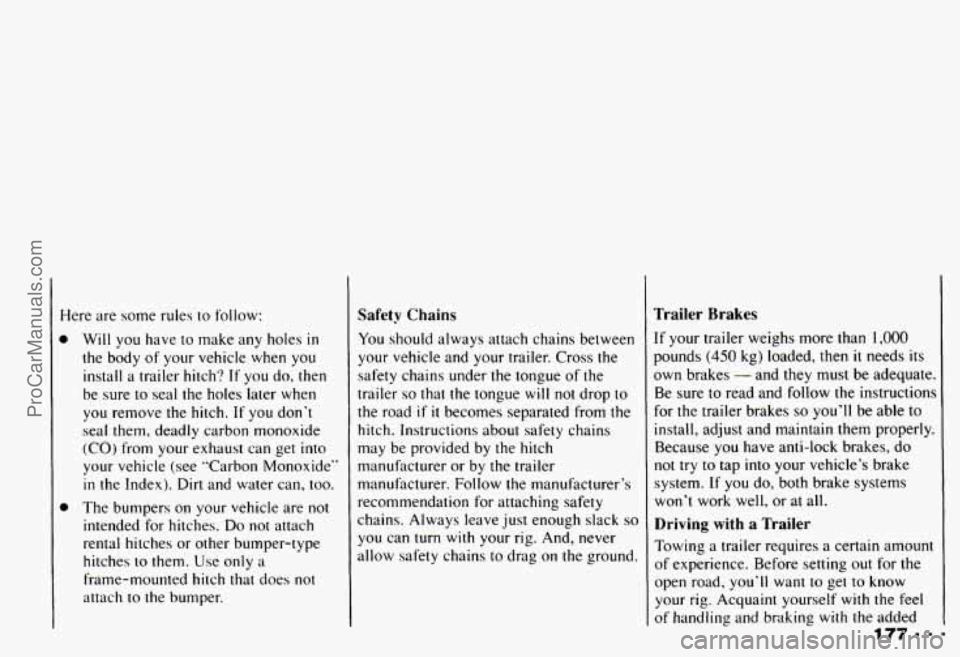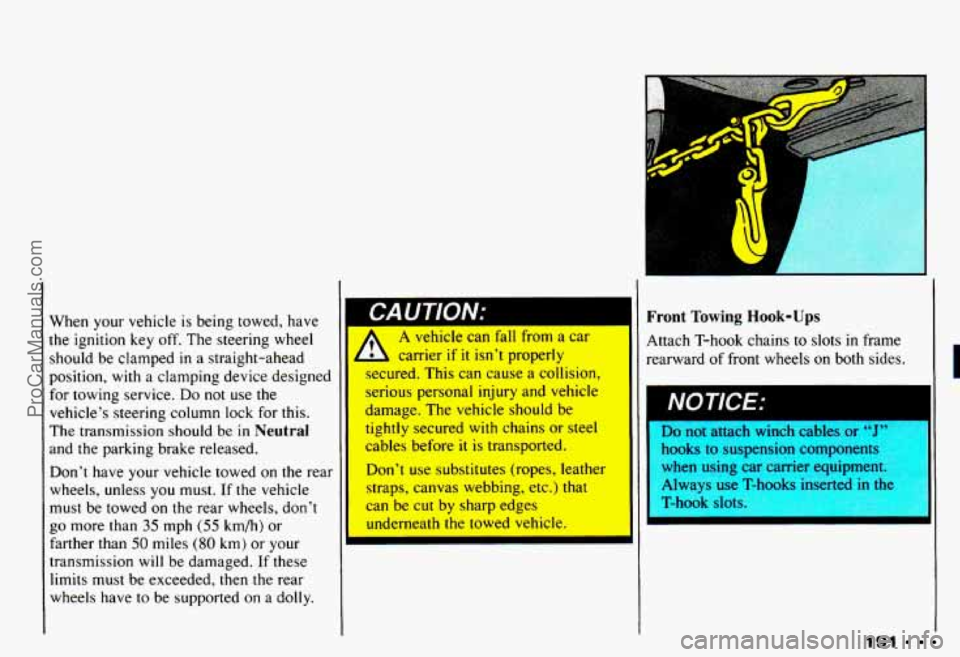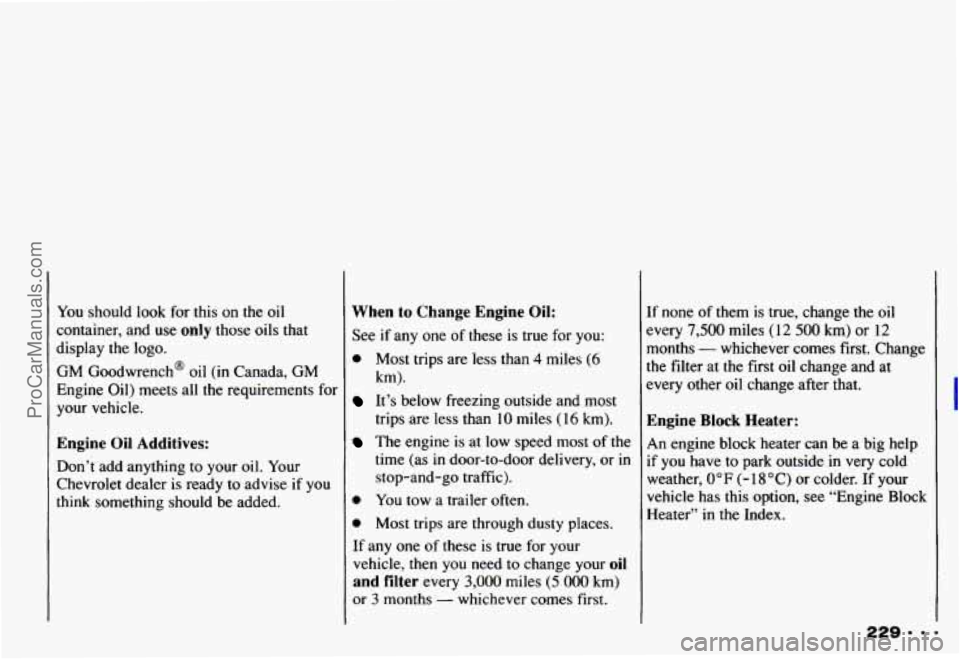Page 181 of 358

Here are some rules to follow:
0
Will you have to make any holes in
the body of your vehicle when you
install a trailer hitch?
If you do, then
be sure to seal the holes later when
you remove the
hitch. If you don't
seal them, deadly carbon monoxide
(CO) from your exhaust can get into
your vehicle (see "Carbon Monoxide"
in the Index). Dirt and water can, too.
The bumpers on your vehicle are not
intended for hitches.
Do not attach
rental hitches or other bumper-type
hitches
to them. Use only a
frame-mounted hitch that does not
attach
to the bumper.
Safety Chains
You should always attach chains between
your vehicle and your trailer. Cross the
safety chains under the tongue
of the
trailer
so that the tongue will not drop to
the road
if it becomes separated from the
hitch. Instructions about safety chains
may be provided by the hitch
manufacturer or by the trailer
manufacturer. Follow the manufacturer's
recommendation for attaching safety
chains. Always leave just enough slack
so
you can turn with your rig. And, never
a Jlow safety chains to drag on the ground.
Trailer Brakes
If your trailer weighs more than 1,000
pounds (450 kg) loaded, then it needs its
own brakes
- and they must be adequate.
Be sure
to read and follow the instructions
for the trailer brakes
so you'll be able to
install, adjust and maintain them properly.
Because you have anti-lock brakes, do
not
try to tap into your vehicle's brake
system. If you
do, both brake systems
won't
work well, or at all.
Driving with a Trailer
Towing a trailer requires a certain amount
of experience. Before setting out for the
open road, you'll want to get to know
your rig. Acquaint yourself
with the feel
of handling and braking with the added
ProCarManuals.com
Page 192 of 358
Problems an the Road
Fans or other moving engine
eep your hands away from moving
-u-ts once the engines are running.
L parts can injure you badly.
6. Connect the red positive (+) cable to
the positive
(+) terminal of the vehicle
with the dead battery. Use a remote
positive
(+) terminal if the vehicle
has one,
I
7. Don't let the other end touch metal.
Connect
it to the positive (+) terminal
of the good battery. Use a remote
positive
(+) terminal if the vehicle
has one.
But don't use the junction
block on your Chevrolet.
ProCarManuals.com
Page 195 of 358

When your vehicle is being towed, have
the ignition
key off. The steering wheel
should be clamped
in a straight-ahead
position,
with a clamping device designed
for towing service.
Do not use the
vehicle’s steering column lock for this.
The transmission should be in Neutral
and the parking brake released.
Don’t have your vehicle towed on the rear
wheels, unless you must.
If the vehicle
must be towed on the rear wheels, don’t
EO more than 35 mDh (55 kmh) or I
CAUTION:
RA
I Front Towing Hook-Ups
A vehicle can fall from a car
Attach T-hook chains to slots in frame
carrier if
it isn’t properly rearward of front wheels on both sides.
secured. This can cause a collision,
tightly secured with chains or steel
cables before
it is transported.
Don’t
use substitutes (ropes, leather
straps, canvas webbing, etc.) that
can be cut by sharp edges
underneath the towed vehicle.
Farther than
50 miles (80 km j or your
transmission
will be damaged. If these
limits must be exceeded, then
the rear
wheels have to be supported on
a dolly.
I.
I
Do not attach winch cables or
1 hooks to suspension components
en using car carrier equipment
I Always use T-hooks inserted in the
I I
I T-hook slots. II
191 ProCarManuals.com
Page 212 of 358
Problems on the Road
H
If your wheel has a center cap, pry it off
using the wheel wrench.
208
If your vehicle has a bolt-on wheel cover,
loosen the plastic caps using the wheel
wrench and remove the wheel cover. If your vehicle has optional alloy wheels,
each wheel may have one locknut in place
of the standard wheel nut. A special wheel
lock key (removal tool) and instructions
are located in the center console. Attach
the wheel lock key to the socket
of the
wheel wrench. Remove the locking wheel
nut by turning counterclockwise.
ProCarManuals.com
Page 214 of 358
Problems on the Road
Raising your vehicle with the jack improperly positioned
will damage
the
vehicle or may allow the vehicIe
to fall
off the jack. Be sure to fit
the jack lift head into the proper
location before raising your vehicle.
I
- 210
Raise the vehicle by rotating the wheel
wrench clockwise. Raise the vehicle far
mough off the ground
so there is enough
room for the spare tire to
fit.
Remove all the wheel nuts and take off
the flat tire.
ProCarManuals.com
Page 216 of 358
Problems on the Road
Lower the vehicle by rotating the wheel
wrench counterclockwise. Lower the jack
completely.
, .:
il
Tighten the wheel nuts firmly in a
criss-cross sequence as shown.
CAUTION:
,A improperly tightened wheel
nuts can cause the wheel to become
loose and even come off. This could
lead to an accident. Be sure to use
the correct wheel nuts. If you have
to replace them, be sure to get the
right kind.
Stop somewhere as soon as you can
and have the nuts tightened with a
torque wrench to 100 pound-feet
( 140 Nmm).
I I Ill
Don't try to put a wheel cover on your
compact spare tire.
It won't fit. Store the
wheel cover
in the rear area until you
have the flat tire repaired or replaced.
NOTICE:
-elcovers won't fit on your
:ompact spare.
If you try to put a
wheel cover on your compact si re,
you
could damage the wer the
spare.
ProCarManuals.com
Page 227 of 358
To take off the cap, turn it slowly to the
left (counterclockwise). When you put the
cap back on, turn it to
the right until
you hear a clicking noise.
I A If you get gasoline on you and
L then something ignites it, you
could be badly
burned. Gasoline can
spray out on you if you open the
fuel filler
cap too quickly. This
spray
can happen if your tank is
nearly full, and is more likely in
hot ~
weather. Open the fuel filler cap
slowly
and wait for any “hiss” noise
to stop. Then unscrew the cap all the
way.
I
1
If you _____1 need a new cap, be sure to get
the right type. Your dealer can get
one for you. If you get the wrong
type, it may not fit and your fuel
tank and emissions system might be -
I damaged.
Checking Things under
the Hood
Hood Release
To open the hood, first pull the handle
inside the vehicle.
223 9 9 9
ProCarManuals.com
Page 233 of 358

You should look for this on the oil
container, and use
only those oils that
display the logo.
GM Goodwrench@
oil (in Canada, GM
Engine Oil) meets all
the requirements for
your vehicle.
Engine Oil Additives:
Don’t add anything to your oil. Your
Chevrolet dealer is ready
to advise if you
think something should be added.
When to Change Engine Oil:
See if any one of these is true for you:
0 Most trips are less than 4 miles (6
km).
It’s below freezing outside and most
trips are less than
10 miles (16 km).
The engine is at low speed most of the
time (as
in door-to-door delivery, or in
stop-and-go traffic).
0 You tow a trailer often.
0 Most trips are through dusty places.
If any one of these is true for your
vehicle, then you need to change your
oil
and filter every 3,000 miles (5 000 km)
or 3 months - whichever comes first. If none
of them is true, change the oil
every
7,500 miles (12 500 km) or 12
months - whichever comes first. Change
the filter at the first oil change and at
every other
oil change after that.
Engine Block Heater:
An engine block heater can be a big help
if you have to park outside in very cold
weather,
0 OF (- 1 8 O C) or colder. If your
vehicle has this option, see “Engine Block
Heater’’
in the Index.
ProCarManuals.com